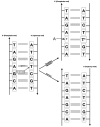External factors affecting fertility, and how to correct their impact
- PMID: 30250655
- PMCID: PMC6143086
External factors affecting fertility, and how to correct their impact
Abstract
Fertility of both men and women has been negatively influenced by external factors and life style in recent decennia. Mechanisms of hormone disruption, oxidative damage, and epigenetic DNA changes play a pivotal role in this process. In Belgium, strict regulations have been imposed to reduce the exposure to xeno-estrogens, which has resulted in a partial recovery of sperm quality. At the other hand, more couples require in vitro fertilisation (IVF) whereby ovarian stimulation may be associated with epigenetic DNA hyper-methylation of follicular cells, and increased risk of carcinogenesis among offspring. In order to reduce the health risks for the offspring it is recommended to optimize the oxidative, epigenetic and metabolic situation of both parents by means of lifestyle adaptation, and the use of appropriate food supplementation before conception and during pregnancy.
Keywords: 8-OH-2 deoxyguanosine; epigenetics; food supplement; hTERT; infertility; oxidative stress.
Figures




Similar articles
-
Preconception nutraceutical food supplementation can prevent oxidative and epigenetic DNA alterations induced by ovarian stimulation for IVF and increases pregnancy rates.Facts Views Vis Obgyn. 2020 May 7;12(1):23-30. Facts Views Vis Obgyn. 2020. PMID: 32696021 Free PMC article.
-
Epigenetic status in the offspring of spontaneous and assisted conception.Hum Reprod. 2014 Jul;29(7):1452-8. doi: 10.1093/humrep/deu094. Epub 2014 May 8. Hum Reprod. 2014. PMID: 24812310
-
A novel antioxidant formulation designed to treat male infertility associated with oxidative stress: promising preclinical evidence from animal models.Hum Reprod. 2016 Feb;31(2):252-62. doi: 10.1093/humrep/dev302. Epub 2016 Jan 4. Hum Reprod. 2016. PMID: 26732620
-
Sperm DNA damage caused by oxidative stress: modifiable clinical, lifestyle and nutritional factors in male infertility.Reprod Biomed Online. 2014 Jun;28(6):684-703. doi: 10.1016/j.rbmo.2014.02.004. Epub 2014 Mar 4. Reprod Biomed Online. 2014. PMID: 24745838 Review.
-
[The importance of sperm epigenetics for conception and embryology].Ugeskr Laeger. 2018 Aug 20;180(34):V02180152. Ugeskr Laeger. 2018. PMID: 30152316 Review. Danish.
Cited by
-
Environmental exposure to cadmium but not lead is associated with decreased semen quality parameters: quality regionalism of sperm properties.Asian J Androl. 2022 Jan-Feb;24(1):26-31. doi: 10.4103/aja.aja_57_21. Asian J Androl. 2022. PMID: 34259199 Free PMC article.
-
Preconception nutraceutical food supplementation can prevent oxidative and epigenetic DNA alterations induced by ovarian stimulation for IVF and increases pregnancy rates.Facts Views Vis Obgyn. 2020 May 7;12(1):23-30. Facts Views Vis Obgyn. 2020. PMID: 32696021 Free PMC article.
-
First custom next-generation sequencing infertility panel in Latin America: design and first results.JBRA Assist Reprod. 2020 May 1;24(2):104-114. doi: 10.5935/1518-0557.20190065. JBRA Assist Reprod. 2020. PMID: 32155011 Free PMC article.
References
-
- Agarwal A, Gupta S, Sharma R. Oxidative stress and its implications in female infertility – a clinician’s perspective. Reprod Biomed Online. 2005;11:641–650. - PubMed
-
- Aitken RJ, Sawyer D. The human spermatozoon - not waving but drowning. Adv Exp Med Biol. 2003;518:85–98. - PubMed
-
- Aitken RJ, Buckingham DW, Carreras A, et al. Superoxide dismutase in human sperm suspensions: relationship with cellular composition, oxidative stress, and sperm function. Free Radic Biol Med. 1996;21:495–504. - PubMed
-
- Aitken RJ, Gibb Z, Baker MA, et al. Causes and consequences of oxidative stress in spermatozoa. Reprod Fertil Dev. 2016;28:1–10. - PubMed
-
- Arhin SK, Zhao Y, Lu XS, et al. Effect of micronutrient supplementation on IVF outcomes: a systematic review of the literature. Reprod Biomed Online. 2017;35:715–722. - PubMed
LinkOut - more resources
Full Text Sources
